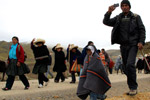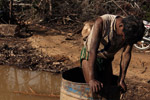
Aerial view of the Río Huaypetue gold mine in Peru. The mine, which was cut of the Amazon rainforest, has been blamed for large-scale environmental damage and social problems, including allegations of child labor. Photo by: Rhett A. Butler.
In an effort to kickstart slowing investment in mining and fossil fuels, Peru has passed a controversial new law that overturns many of its environmental protections and essentially defangs its Ministry of Environment. The new law has environmentalists not only concerned about its impact on the country—60 percent of which lies in the Amazon rainforest—but also that the measures will undermine progress at the up-coming UN Climate Summit in December, which Peru is hosting.
The new law, signed by President Ollanta Humala earlier this month, is thorough in its application. It significantly reduces most fines for environmental damages, forces environmental impact studies to be done in just 45 days, and will allow mining and fossil fuel exploitation in any newly-formed protected areas.
“We consider these measures as a serious pullback for Peru in the environmental field. We urge the Peruvian government to reconsider and withdraw this initiative,” wrote over 100 local and international environmental groups in a letter protesting the new law.
The law also undercuts the Ministry of Environment, which was only established in 2008, by no longer allowing the ministry to set standards for air, soil, and water quality. Not surprisingly, the head of the ministry, Manuel Pulgar-Vidal, voted against the bills.
Finally the new law enacts large tax breaks for foreign mining companies operating in the country.
Yet, Peru continues to be roiled by entrenched conflicts between local communities and mining and oil companies. Indigenous people in the Amazon have protested oil exploration and exploitation in their traditional territories for decades, while many Andean communities have campaigned against ever-expanding mines.
 Oil and gas blocks in the western Amazon. Solid yellow indicates blocks already leased out to companies. Hashed yellow indicates proposed blocks or blocks still in the negotiation phase. Protected areas shown are those considered strictly protected by the IUCN (categories I to III). Image modified from Finer at al (2008). |
Conflicts have even turned violent. In 2009, a protest against a new law opening up vast areas of the Amazon to logging, mining, and fossil fuel exploitation ended in the deaths of 23 police officers and at least 10 indigenous protestors. The law that spurred the incident was eventually overturned and the president who championed it, Alan Garcia, was voted out of office. His replacement, Humala, was elected with hopes—and promises—that he could better mitigate the conflict between multinational industries and local communities.
In fact, environmentalists were heartened by some developments in Peru since Humala’s election. For example, last year Peru declared a state of emergency due to decades of oil pollution in the Pastaza River in the Amazon. This state of emergency, which compelled oil giant Pluspetrol to clean-up the area, was only brought about by the Ministry of Environment’s nascent soil and water standards, which the new law axes.
The Associate Press reports that Peru enacted the law in response to its slowing economic growth, which dropped from 6.3 percent in 2012 to 5 percent last year. The Latin American country is heavily dependent on mining and fossil fuels. Currently, mining makes up about 60 percent of exports, with gold accounting for around a third of that. Meanwhile about 70 percent of the Peruvian Amazon has been auctioned off to oil companies for exploration.
Critics of the new law also fear its ramifications could spread beyond Peru.
“In the context of the global climate crisis, where concrete and urgent actions are required, this newly proposed law sends a very bad signal which is made even worst considering Peru’s role as COP [Conference of the Parties] 20 President,” wrote the environmental groups. “This proposed investment law rewards those parties who do not comply with current environmental rules in Peru.”
One of the responsibilities of holding the current presidency of the UN Framework Convention on Climate Change’s Conference of the Parties—which moves from country to country every year—is hosting the annual climate change summit in December of this year. Hopes have been rising for the conference as it paves the way for a new agreement in Paris in 2015. But as host, Peru could have considerable sway over the outcome of this year’s conference. Recent hosts, Poland and Qatar, have both been criticized for not doing enough to push ambition at summits over the past two years.
“We are at a crucial moment when Peru is required and expected to step up and show consistent and coherent leadership to develop environmental policies in the face of climate change,” the environmental groups wrote.
A few days after the new law passed, Pulgar-Vidal, the Environment Minister, said the country was on track for a bold summit.
“We have received a good signals and strong political support,” he told summit delegates in Petersburg. “Our main goal is to have a strong focus and draft agreement, it’s the only way to move towards a strong COP in Paris.”
Related articles
Roads through the rainforest: an overview of South America’s ‘arc of deforestation’

(07/21/2014) When a new road centipedes its way across a landscape, the best of intentions may be laid with the pavement. But roads, by their very nature, are indiscriminate pathways, granting access for travel and trade along with deforestation and other forms of environmental degradation. And as the impacts of roads on forest ecosystems become clear, governments and planning agencies reach a moral crossroads.
Oil drilling causes widespread contamination in the Amazon rainforest
(06/13/2014) Decades of oil extraction in the Western Amazon has caused widespread pollution, raising questions about the impact of a new oil boom in the region, according to a team of Spanish researchers presenting at a conference in California.
53 indigenous activists on trial for police-protester massacre in Peru

(05/15/2014) In the summer of 2009, on a highway in Peru known as Devil’s Curve: everything went wrong. For months, indigenous groups had protested new laws by then President Alan Garcia opening up the Amazon to deregulated logging, fossil fuels, and other extractive industries as a part of free trade agreements with the U.S.
New report reveals human rights abuses by corporations, governments in the Amazon

(05/14/2014) Regnskogfondet (the Rainforest Foundation of Norway) recently released a 52-page report that gives an in-depth account of the conflicts activists and indigenous peoples (IPs) are having with corporations and governmental agencies. It relays a situation that does not look good.
Legal logging concessions drive illegal logging in Peru, threatening forests and indigenous people

(04/17/2014) Nearly 70 percent of officially inspected logging concessions in Peru have had their permits canceled or are under investigation for major breaches of forestry laws, finds a new study published in the journal Scientific Reports. Worryingly, the research also concludes that forestry permits are being widely used to launder timber illegally logged from outside concession areas.
The price of gold: winners and losers in Latin America’s mining industry

(03/05/2014) On a Friday afternoon in June, the Plaza de Armas in Cajamarca is pulsing with life. It’s winter here, and although thick white clouds hover low in the distance, the sun in this northern Peruvian city is warm. Couples sit on benches facing one another. Kids run in the grass between flowerbeds. Men in suits stride along the perimeter. It’s an idyllic day. But signs of something more ominous are not far from sight. On the mountainside overlooking the town the words Nova Conga have been carved into the vegetation. It is a constant reminder that beyond the square, hemmed with international hotels and expensive restaurants, there is another reality.
The making of Amazon Gold: once more unto the breach

(02/19/2014) When Sarah duPont first visited the Peruvian Amazon rainforest in the summer of 1999, it was a different place than it is today. Oceans of green, tranquil forest, met the eye at every turn. At dawn, her brain struggled to comprehend the onslaught of morning calls and duets of the nearly 600 species of birds resounding under the canopy. Today, the director of the new award-winning film, Amazon Gold, reports that “roads have been built and people have arrived. It has become a new wild west, a place without law. People driven by poverty and the desire for a better life have come, exploiting the sacred ground.”
Gas company to drill in Manu National Park buffer zone, imperiling indigenous people
(02/04/2014) The Peruvian government has approved plans for gas company Pluspetrol to move deeper into a supposedly protected reserve for indigenous peoples and the buffer zone of the Manu National Park in the Amazon rainforest. The approval follows the government rescinding a highly critical report on the potential impacts of the operations by the Culture Ministry (MINCU), the resignation of the Culture Minister and other Ministry personnel, and repeated criticism from Peruvian and international civil society.